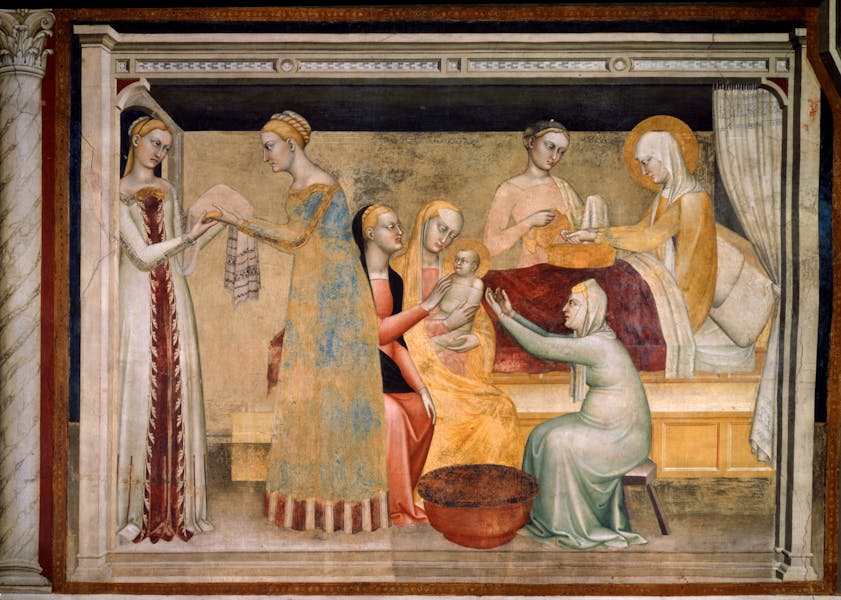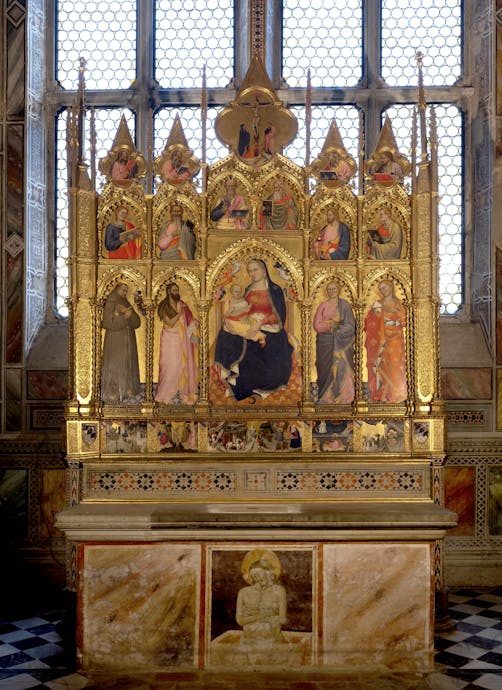
Rinuccini Chapel
Opening off the east wall of the sacristy, this square chapel has a cross-vaulted ceiling and is lit by two two-light windows in the back wall, surmounted by the Guidalotti coat-of-arms.
The chapel was founded and decorated with money from a legacy left by Lapo di Lizio Guidalotti in a will he drafted before 1355. The executor was Fra' Ludovico di Giovanni, custodian of the convent of Santa Croce, who very probably also chose the chapel's dedication to the Nativity of the Virgin and to Mary Magdalen, given that both play such a crucial role in the Franciscan message.

Giovanni da Milano, Nativity of the Virgin, scene from the Stories from the Life of the Virgin, c. 1359-66. Basilica of Santa Croce, Sacristy, Rinuccini Chapel
The chapel's fresco decoration was painted between 1359 and 1371. Giovanni da Milano frescoed the panels in the vault with four figures of prophets in polylobate frames and sealed the vault itself with a wooden tondo bearing the figure of Christ Pantocrator on a gold ground (c. 1365), a solution rarely seen in Tuscany. He also frescoed the upper two registers on each side wall, while the lower registers were completed by an artist known by the conventional name of Master of the Rinuccini Chapel and subsequently identified as Matteo di Pacino, a master involved in the illumination of choir books for the church.
The left-hand wall has Stories from the Life of the Virgin akin both stylistically and in the choice of episodes to the frescoes in the Baroncelli Chapel. The stories on the right-hand wall are a rare example of a figurative cycle dedicated to Mary Magdalen, illustrated in accordance with the medieval custom of adding episodes originally relating to Mary of Bethany and Mary of Egypt.
Francesco Rinuccini completed the decoration when he acquired the patronage of the chapel c. 1371. The wrought-iron railing, probably made in Siena, carries the date 1371, which might indicate that the frescoes were completed in that year. The railing served to mark the point where Rinuccini's patronage ended and the sacristy began.
The 14th century décor includes the altar with a polyptych by Giovanni del Biondo dated 1379. The central panel shows the Virgin and Child Enthroned, the side panels have figures of Saints, the upper panel has Apostles and Evangelists and the cusp holds a Crucifixion. The predella panels narrate episodes from the life of the corresponding saint above each one, an ancient custom that withstood the test of time. The panels sit within a rich Gothic frame, and the altar is completed by an altar frontal with a coeval depiction of Christ the Man of Sorrows.
Despite a few 18th and 19th century alterations, the chapel has managed to maintain its late medieval character.

Giovanni del Biondo, Rinuccini Panel, 1379. Basilica of Santa Croce, Sacristy, Rinuccini Chapel